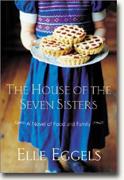The House of the Seven Sisters
Elle Eggels
book reviews:
· general fiction
· chick lit/romance
· sci-fi/fantasy
· graphic novels
· nonfiction
· audio books
· author interviews
· children's books @
curledupkids.com
· DVD reviews @
curledupdvd.com
newsletter
win books
buy online
links
home
for authors
& publishers
for reviewers

 |
The House of the Seven Sisters: A Novel of Food and Family Elle Eggels translated from Dutch by David Colmer William Morrow & Co. Hardcover 288 pages December 2002 |
|
The House of Seven Sisters by Dutch writer Elle Eggels makes me wish I had sisters. Eggels' is such a lively, domestic novel. Set in the Netherlands in the early to mid-20th century, it centers on the lives of seven sisters who live without a mother or father, mostly together in the same house, for the course of about thirty years. The book's narrator is a child, the daughter of the oldest sister, Martha.
The sisters perform all the appropriate domestic duties of women from their era. Most of them bake, taking their loaves and rolls on the road by horse carriage and, finally, by van. They also embroider, they make dresses, they fill dowry chests, they cook elaborate meals. They love to drink gin and tell stories in the evening. Theirs is a matriarchal household; at a certain point, yet another woman with no children, Oma, comes to join them. Toward the end of the tale, their father's second wife joins them, but this relationship ends up in disaster. The women are strong, quixotic and opinionated. For example,"She [Martha] felt more useless than stale bread... at least that was still good enough for pigs." When the narrator goes to a preschool, which she hates because she has to get her hands dirty working with clay, she reflects, "I would gain access to a new science that would allow me to transcend myself. Such a thing could only be possible through the mediation of a nun, because in my eyes nuns were extraterrestrials." Despite her attitude, the family remains devout, making many confessions for transgressions along their way. Various husbands, lovers and male friends come and go, but few stay for long. Some die; some the women leave. The strongest connections in this novel are between the sisters. The language of the translated novel is delightful. The novel sometimes reads like a fairy tale; it has been compared to magic surrealism such as works by Gabriel Garcia Marquez or Laura Esquivel. Vivid dreams and appearances of white-clothed female apparitions are common. A little gem of a novel, quaint and loving, it portrays a vivid picture of a large family living in Europe at a certain time in history. Still, keeping the characters' stories and relationships straight remains a bit of a trial. © 2003 by Deborah Straw for Curled Up With a Good Book |
|
|
|
 Click here to learn more about this month's sponsor! |
|
| fiction · sf/f · comic books · nonfiction · audio newsletter · free book contest · buy books online review index · links · · authors & publishers reviewers |
|
| site by ELBO Computing Resources, Inc. | |
 The sisters run a bakery in a small town, and their roles within the
bakery shift and change. In fact, the entire novel shifts back and
forth between episodes in the lives of the various sisters. At times,
this is confusing and I found myself wishing for a group photo or a
genealogical tree. By the novel's end, two of the sisters have died and
the narrator has married, had her own son and gone to visit Mexico,
where the novelist once lived.
The sisters run a bakery in a small town, and their roles within the
bakery shift and change. In fact, the entire novel shifts back and
forth between episodes in the lives of the various sisters. At times,
this is confusing and I found myself wishing for a group photo or a
genealogical tree. By the novel's end, two of the sisters have died and
the narrator has married, had her own son and gone to visit Mexico,
where the novelist once lived.